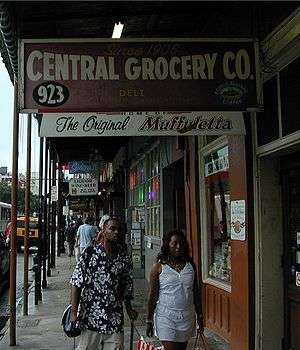Italians in New Orleans
| Part of a series on |
| Ethnicity in New Orleans |
|---|
|
|
|
|

Italians have had a presence in the area since the explorations of the Europeans.[2] Many Sicilians immigrated to New Orleans in the 19th century, traveling on the Palermo-New Orleans route by ship.[3] Almost all of the 19th-century immigrants to the city originated from Sicily.[4] Overall most Italian immigration occurred during the late 19th century, with those immigrating from that century outnumbering Italians who had immigrated prior to the American Civil War.[5]
The March 14, 1891 lynchings occurred after the 1890 assassination of the chief of police, David Hennessy.[6][7] It was the largest ever mass lynching in Louisiana history.[7]
Geography
"Little Palermo" was established in the lower French Quarter. As time passed, many Italian Americans moved out of New Orleans and to the suburbs.[4]
Economy
Historically many corner stores in New Orleans were owned by Italians. Progresso Foods originated as a New Orleans Italian-American business.[4] The business established by the Vaccaro brothers later became Standard Fruit.[5]
After they first arrived, Italian immigrants took low wage jobs.[5] They worked on docks, in Macaroni factories, and in nearby sugar plantations. Some went to the French Market to sell fruit.[4] Italian workers became a significant presence in the French Market.[5]
Organizations
In 1843 the Società Italiana di Mutua Beneficenza was established. The San Bartolomeo Society, established by immigrants from Ustica, was established in 1879. As of 2004 it is the oldest Italian-American society in New Orleans. Joseph Maselli, an ethnic Italian from New Orleans, founded the first pan-U.S. Italian-American federation of organizations.[3]
The American Italian Cultural Center honors and celebrates the area's Italian-American heritage and culture. The AICC houses the American Italian Museum, with exhibits about the history and contributions of Italians-Americans to the region.
Recreation
On St. Joseph's Day ethnic Sicilians in the New Orleans area establish altars.[4] On that day marches organized by the Italian-American Marching Club occur. The club, which welcomes anyone of Italian origins, started in 1971 and as of 2004 has over 1,500 members.[1]
Italian Americans established the Krewe of Virgilians because they were unable to join other Krewes. In 1936 the krewes crowned their first queen, Marguerite Piazza, who worked in the New Orleans Metropolitan Opera.[3]
Cuisine

Italian-American features of New Orleans cuisine include the muffuletta and the tomato sauce-based red gravy.[4]
Notable people
- Sam Butera[1]
- Dukes of Dixieland (Frank Assunto, Freddie Assunto, Papa Assunto)[1]
- Nick LaRocca[1]
- Carlos Marcello
- Louis Prima[1]
- Vaccaro brothers (including Joseph Vaccaro), who established Standard Fruit[5]
- Joe & Sal Impastato
- Cosimo Matassa
References
- Maselli, Joseph and Dominic Candeloro. Italians in New Orleans (Images of America). Arcadia Publishing, 2004. ISBN 0738516929, 9780738516929.
Notes
- 1 2 3 4 5 6 Maselli and Candeloro, p. 8.
- ↑ Maselli and Candeloro, p. 9.
- 1 2 3 Maselli and Candeloro, p. 7.
- 1 2 3 4 5 6 Maggi, Laura. "Italian immigrants: The Times-Picayune covers 175 years of New Orleans history." The Times-Picayune. January 29, 2012. Retrieved on August 28, 2014.
- 1 2 3 4 5 Huber, Leonard Victor. New Orleans: A Pictorial History. Pelican Publishing, 1971. ISBN 1455609315, 9781455609314. p. 56.
- ↑ "1890: New Orleans police chief is assassinated." The Times-Picayune. September 24, 2011. Retrieved on August 28, 2014.
- 1 2 "ANTI-ITALIAN MOOD LED TO 1891 LYNCHINGS" (Archive). The Times-Picayune. March 14, 1991. p. B1. Retrieved on August 28, 2014.
Further reading
- Rimanelli, Marco and Sheryl Lynn Postman. The 1891 New Orleans Lynchings and U.S.-Italian Relations: A Look Back (Volume 2 of Studies in Southern Italian and Italian-American Culture). P. Lang, 1992. ISBN 082041672X, 9780820416724. - See Google Books profile
- Falco, Ed. "When Italian immigrants were 'the other'" (Opinion) (Archive). CNN. July 10, 2012.